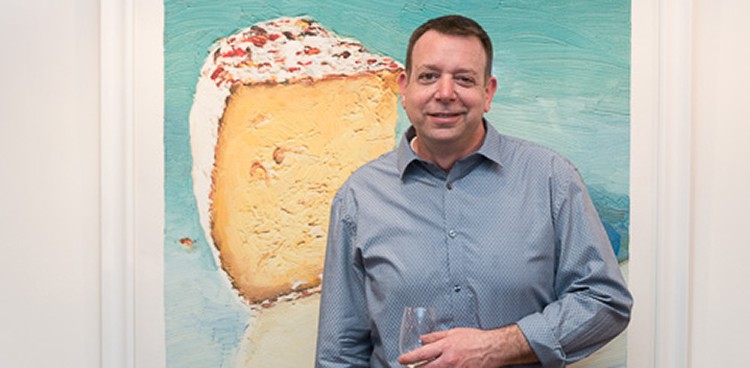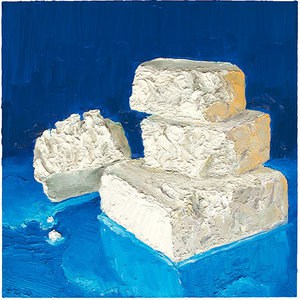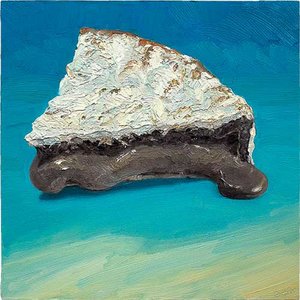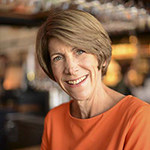

Planet Cheese is a weekly blog devoted to everything cheese: products, people, places, news, and views. James Beard Award–winning journalist Janet Fletcher writes Planet Cheese from her home in Napa Valley. Janet is the author of Cheese & Wine, Cheese & Beer, and The Cheese Course and an occasional contributor to culture. Visit janetfletcher.com to sign up for Planet Cheese and view Janet’s current schedule of cheese appreciation classes.
They say a picture is worth . . . well, you know. Who needs words to appreciate Cowgirl Creamery Devil’s Gulch when you have Mike Geno’s appetizing depiction? You want to grab a baguette and a knife and dive in. Geno’s luscious portraits convey the peppery scent of Devil’s Gulch (above); the slouch in a pudgy slice of Grayson; the cool, marbled elegance of Bay Blue. Now, with nearly 300 cheeses under his belt, is it time to move on?
You’re a fine-art painter with a cheese obsession. There must be a back story.

Caerphilly: real and imagined
It wasn’t intentional. Someone had given me a gift certificate for Di Bruno Bros in Philadelphia. I didn’t consider Di Bruno’s a place where I could shop because of my budget, but everybody in Philly knows Di Bruno. I told the cheesemongers I had this $25 gift certificate and didn’t know what to do with it, and they knew exactly how to talk to people like me. I fell in love with Caerphilly and said, “I’ll take $25 worth of that.”
The painting happened because I couldn’t just eat it. It was too beautiful: very cake-like with this interesting rind and change of color from the outside in. It reminded me of a Wayne Thiebaud painting.
I wondered if Thiebaud was an inspiration. Your style is similar.
When I was younger, whether I was painting a cupcake or a slab of meat, I was trying to translate what I found attractive. I was using the quality of the brush strokes to further describe my subject, beyond just color and shape. When I started to work that way, people said, “You really should look at Wayne Thiebaud.” I went to a museum and saw his work and was in a daze. He uses very thick paint to make his cake paintings, and his indulgence in saturated color and juicy brush strokes make me salivate.
And then one cheese portrait led to another…?
I needed a new body of work for a show, and I remembered that I had met Madame Fromage at a party. She told me she had a cheese blog. So I e-mailed her and asked if there were more places to get cheese than Di Bruno’s, and were there even enough worthy cheeses to do a series of 25 or 30?
That was 300 cheese paintings ago.
The cheese world, as it turned out, provided a subject where I could tap into community and connect the audience to what they eat, to nourishment and tradition. The best cheesemongers don’t just sell you a product, they sell you a story and a community with it, and I feel like that’s important. This would be really boring if I wasn’t thinking about the stories.
That’s why I call them portraits, not paintings. They felt like portraits from the beginning. I felt like they had a lot of personality.
How hard is cheese to paint?
Some people have said to me, “You paint cheese? How do you make the paint stick to it?”

Greek Feta
It depends on the size of the painting and complexity, but I paint them in 6 to 11 hours. I have to work fast. With runny cheese, there’s pressure to be really quick. If I don’t get it right before it starts moving, I have to start over. I learned not to do Epoisses in summer; that was a mistake.
I love a challenge, so I did Bay Blue with foil crumpled around it. But the cheeses with the least features are the most challenging. For feta, I had light coming from the right, and on the left side, out of the picture plane, I had a yellow-orange sheet of paper that reflected back so the shadow side had warmer color. I try to taste a little before I start painting, but I don’t think that does anything magical.

Ocean Brie-eze
When Peter and Rachel Dixon (from Parish Hill Creamery) were in Hawaii, Rachel found a squid-ink brie. I said, “You need to bring some of that back for my map project!” (Geno hopes to paint cheese from all 50 states.) I knew it was my only chance of getting Hawaiian cheese. It was so ripe when I got it that I knew I had only one shot at it. I took a photograph just in case, but I painted as quickly as I could. I knew from experience to focus on the paste first—the rind wasn’t going to change much. It worked, but it was a close call.
You almost never put anything else in these paintings. No trays, no implements.
I love making it an isolated subject. People have said to me, “Finally, cheese is center stage instead of just a prop in a still life.”
Is the end in sight?
I don’t know. For the last couple of years, I’ve been waiting for the interest to die. I’ve kept my prices low because I know most of my buyers are not art collectors but cheese lovers. But new people are discovering my work, and I found out there’s never going to be a shortage of cheese. I thought I would get tired of it, but I feel like I’m getting better. If I’m bored, the painting will be boring. There’s no way of bullshitting it really. If you see a painting and think it’s successful, that artist was probably very much enjoying the process.




